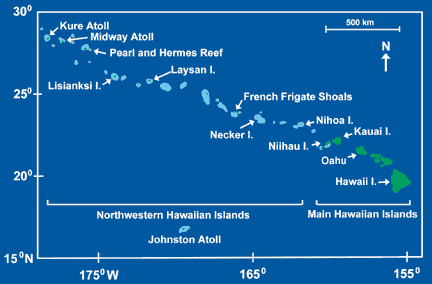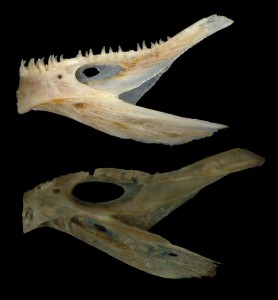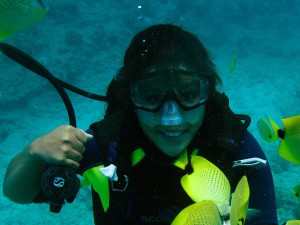
MSc Student
Tel: 604.822.8181
Fax: 604.822.8180
E-mail: m.wong@oceans.ubc.ca
Supervisor: Dr. Andrew Trites
Education: BSc in Animal Biology (University of British Columbia 2002)
Research Interests: Foraging ecology, parasitology, biophysics
Research Area: Northwestern Hawaiian Islands
Does ocean temperature affect the diet of Hawaiian monk seals?
Problem
Hawaiian monk seals are found in the main Hawaiian Islands and the Northwestern Hawaiian Islands. In the past few decades, the number of seals has decreased dramatically.

Emaciated Hawaiian monk seal pup
This is mainly because few juvenile seals will survive to adulthood in the Northwestern Hawaiian Islands. Emaciated seal pups are spotted far too frequently, so it is possible that they are not getting enough food to survive. It is up to scientists to determine what factors are affecting the decline of the Hawaiian monk seal.
In order to understand the ecology of an animal, it is important to determine what they are eating and what affects their diet. In other parts of the world, seal and sea lion populations have crashed after El Niño events because of increased sea-surface temperatures and the resulting decline in available prey. However, El Niño events are associated with cooler waters in Hawaii, and studies have shown improved body condition and survival of Hawaiian monk seal pups and juveniles following El Niño years. These cooler waters can lead to improved diet or foraging efficiency of Hawaiian monk seals through changes in prey availability, distribution, or quality.
Research Questions
My research focuses on the breeding atoll of French Frigate Shoals, the most southeastern breeding atoll in the Northwestern Hawaiian Islands, which houses the largest breeding population of Hawaiian monk seals.
I am determining the types and number of prey being eaten by Hawaiian monk seals over a period from 1995 to 2007.
I will also be looking at whether Hawaiian monk seals consume different types or quantities of prey between El Niño (cool) and La Niña (warm) years.
Approach
I am using scat sample analysis to determine the diet of Hawaiian monk seals.
Fecal samples are collected by researchers at the breeding atolls in the Northwestern Hawaiian Islands each summer. The samples are then shipped back to the Bishop Museum in Honolulu, where the fecal material is washed away and hard remains are separated for identification.
Cephalopod (squid and octopus) beaks and fish bones and scales are then compared to a reference collection to determine the type and number of prey being consumed by Hawaiian monk seals. For instance, I would compare a digested dentary bone as pictured on the left to the dentary bones in the reference collection to determine that this fish is from the family Priacanthidae (Bigeyes).
This data can be used to paint a picture of how Hawaiian monk seals forage. Do they tend to forage on shallow coral reefs, or dive deep and forage on sandy floors? Do they tend to forage at night or during the day? I am also comparing dietary data to sea surface temperatures in Hawaii from 1995 to 2007 to see if the diet of Hawaiian monk seals changes in response to changing ocean temperatures.
Preliminary Findings
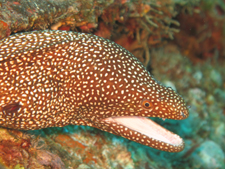
Moray eels are commonly consumed by Hawaiian monk seals
I have cleaned and sorted almost 600 fecal samples, and identified the remains of over 900 cephalopods (octopus and squid), 1400 marine eels, and 6000 fish.
Hawaiian monk seals eat a wide variety of prey including crustaceans, cephalopods, 4 families of marine eels, and 32 families of fish. Of these, 6 species of fish were not previously known to occur in the diet. The most commonly occurring fish in the diet are families which can often be seen while snorkeling or scuba diving, and are generally associated with reef or sandy habitats. I am currently looking at changes in the diet in response to changing sea surface temperatures.
Brief Bio
I started working with the Marine Mammal Research Unit in 2000 as a Research Technician with the captive Steller sea lion research program at the Vancouver Aquarium. After graduation, I returned to the Marine Mammal Research Unit as a Predator/Prey Research Technician, examining the diet of Steller sea lions in southeast Alaska. Following this study, I moved to Hawaii for a year to begin analysis of the diet of Hawaiian monk seals prior to starting my Masters degree.
Publications
- Tollit, D.J., M.A. Wong, and A.W. Trites. In preparation. Choice of dietary indices, correction factors, and sampling strategies affect estimates of diet composition of Steller sea lions (Eumetopias jubatus).
- Sigler, M.F., D.J. Tollit, J.J. Vollenweider, J.F. Thedinga, D.J. Csepp, J.N. Womble, M.A. Wong, M.J. Rehberg and A.W. Trites. 2009. Steller sea lion foraging response to seasonal changes in prey availability. Marine Ecology Progress Series 388:243-261.

- Tollit, D.J., M. Wong, A.J. Winship, D.A.S. Rosen, and A.W. Trites. 2003. Quantifying errors associated with using prey skeletal structures from fecal samples to determine the diet of the Steller sea lion (Eumetopias jubatus). Marine Mammal Science 19(4): 724-744.

Presentations
- Wong, M.A., C.L. Littnan, and A.W. Trites. Hooray for El Niño!? Do climate changes alter the diet of Hawaiian monk seals? 18th Biennial Conference on the Biology of Marine Mammals. October 12-16, 2009. Quebec City, QC, Canada.
- Wong, M.A., C.L. Littnan, D.J. Tollit, and A.W. Trites. Do El Niño-Southern Oscillation events affect the diet of Hawaiian monk seals? 17th Biennial Conference on the Biology of Marine Mammals, November 29 – December 3, 2007. Cape Town, South Africa.
| I appreciate the help and support provided by: | |||
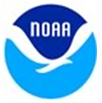 |
 |
 |
|

